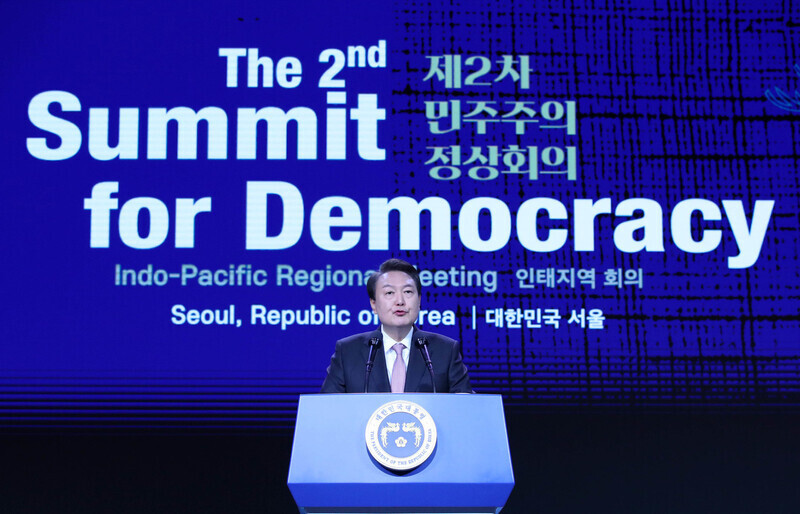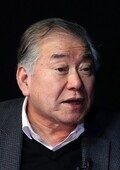hankyoreh
Links to other country sites 다른 나라 사이트 링크
[Column] Whom does the shift from Asia-Pacific to Indo-Pacific serve?


By Moon Chung-in, professor emeritus at Yonsei University
“The era of the Asia-Pacific is over, and the new age of the Indo-Pacific has begun.”
That remark is often made at international conferences not only in Korea and the US but also in Europe. The geopolitical concept of the Indo-Pacific seems to be overtaking the geographical concept of the Asia-Pacific.
Has the Asia-Pacific order truly come to an end? I’m not inclined to agree.
Dramatic changes in a regional order take place as the result of large wars between great powers or internal political changes to these powers, like revolutions. Some of the best-known examples are the Vienna System that followed the Napoleonic Wars, the League of Nations after World War I, the Cold War conflict between the US and the Soviet Union after World War II, and the post-Cold War order resulting from the collapse of the Soviet Union.
What strikes me as so peculiar is that the Indo-Pacific strategy — first proposed by former Japanese Prime Minister Shinzo Abe and then elaborated by US Presidents Donald Trump and Joe Biden — and the resulting new order in the region have emerged as a predominant paradigm in such a short time, even as the previous Asia-Pacific order remains intact.
When the Cold War came to an end in the early 1990s, a regional reorganization took place under the US-led unipolar system. First, the EU moved to form an independent economic bloc. Afraid of being left behind, the US formed the North American Free Trade Agreement, joining Canada and Mexico, and also played an active role in the Asia-Pacific Economic Cooperation (APEC) forum, which was spearheaded by Japan and Australia.
That marked the beginning of the age of the Asia-Pacific.
The Asia-Pacific order in the post-Cold War era was positive in several respects.
Comprising 21 countries from Asia, North and South America, and the Pacific Rim, APEC became a prime example of open regionalism and free trade. While there have admittedly been a number of challenges, such as disagreements between developed and developing countries, that framework has produced a variety of bilateral free trade agreements as well as multilateral agreements including the Comprehensive and Progressive Agreement for Trans-Pacific Partnership (CPTPP), the Regional Comprehensive Economic Partnership (RCEP) and the ASEAN Free Trade Area (AFTA).
Furthermore, the launch of the Asia-Europe Meeting (ASEM) forged a connection between Asia and Europe and served as the cornerstone for a regional free trade order. The APEC summit, held annually, has become a forum for political and security deliberations at the highest level. And ASEAN has led Asian-Pacific security deliberations that include China and Russia, opening up new possibilities for security cooperation on a multilateral level.
Regional exchange and cooperation have become more vibrant despite differing political systems and values, leading to the formation of some degree of strategic consensus. It’s no exaggeration to say that the peace and prosperity that the Asia-Pacific region has enjoyed since the 1990s is the product of this regional order, which encompasses both continental and maritime powers.
While the Indo-Pacific Strategy seeks to make the Indian and Pacific Oceans “free and open” (according to the US) or “peaceful and prosperous” (according to Korea) and presents inclusion, trust and reciprocity as the principles of cooperation (according to Korea), that strategy is seriously at odds with the Asia-Pacific order.
We need look no further than trilateral military cooperation between the US, Japan and South Korea, which can be considered a subset of the Indo-Pacific strategy, as well as the Quadrilateral Security Dialogue, AUKUS, and NATO’s expanding reach.
In its essence, the Indo-Pacific strategy is the latest incarnation of the traditional US maritime strategy of linking the Pacific, Indian and Atlantic oceans, as well as a geopolitical move aimed at containing China’s attempts to change the status quo and expand its influence. Therefore, the strategy is focused on collective defense and exclusive alliances.
The us-or-them logic of “values diplomacy” is used as justification for that strategy. Democratic states are supposed to come together in a coalition to resist the axis of authoritarian states, including China, Russia and North Korea.
In the economic arena, this strategy is characterized by the closed regionalism of the Indo-Pacific Economic Framework (IPEF). The US is pushing its friends and allies to decouple from China in the areas of trade and technology. As implied by such terms as re-shoring, near-shoring, and friend-shoring, the ultimate goal of the strategy in the Indo-Pacific is the exclusion of China.
A recent report by the International Monetary Fund warns that this sort of geopolitical and geoeconomic realignment would inflict fatal harm on the global economy.
While the Indo-Pacific strategy may make a great deal of sense from the perspective of the US and Japan, which view the rise of China as an existential threat, their opinions and interest may differ sharply from those of other countries in the region.
That’s especially true when we consider the severe collateral damage that would result from forcing those countries to choose between the two orders.
Furthermore, the Asia-Pacific order is still far too useful for us to pen its obituary.
But unfortunately, most countries are uncritically accepting the transition to the Indo-Pacific without any substantial debate among academics or policymakers about the appropriateness of that transition.
Is there really no way for the Asia-Pacific and Indo-Pacific orders to coexist or even thrive together? Shouldn’t somebody be tallying up the regional costs and benefits of joining the Indo-Pacific strategy? In the case of peninsular countries such as Korea, is it actually desirable to abandon the continent and throw our lot in with a maritime strategy?
Korea has long been the greatest beneficiary of the Asia-Pacific order. The time has come for us to find our own answer through lively discussion and debate.
Please direct questions or comments to [english@hani.co.kr]

Editorial・opinion
![[Column] Has Korea, too, crossed the Rubicon on China? [Column] Has Korea, too, crossed the Rubicon on China?](https://flexible.img.hani.co.kr/flexible/normal/500/300/imgdb/original/2024/0419/9317135153409185.jpg) [Column] Has Korea, too, crossed the Rubicon on China?
[Column] Has Korea, too, crossed the Rubicon on China?![[Correspondent’s column] In Japan’s alliance with US, echoes of its past alliances with UK [Correspondent’s column] In Japan’s alliance with US, echoes of its past alliances with UK](https://flexible.img.hani.co.kr/flexible/normal/500/300/imgdb/original/2024/0419/2317135166563519.jpg) [Correspondent’s column] In Japan’s alliance with US, echoes of its past alliances with UK
[Correspondent’s column] In Japan’s alliance with US, echoes of its past alliances with UK- [Editorial] Does Yoon think the Korean public is wrong?
- [Editorial] As it bolsters its alliance with US, Japan must be accountable for past
- [Guest essay] Amending the Constitution is Yoon’s key to leaving office in public’s good graces
- [Editorial] 10 years on, lessons of Sewol tragedy must never be forgotten
- [Column] A death blow to Korea’s prosecutor politics
- [Correspondent’s column] The US and the end of Japanese pacifism
- [Guest essay] How Korea turned its trainee doctors into monsters
- [Guest essay] As someone who helped forge Seoul-Moscow ties, their status today troubles me
Most viewed articles
- 1[Column] The clock is ticking for Korea’s first lady
- 2Samsung barricades office as unionized workers strike for better conditions
- 3After 2 months of delayed, denied medical care, Koreans worry worst may be yet to come
- 4[Correspondent’s column] In Japan’s alliance with US, echoes of its past alliances with UK
- 5[Column] Has Korea, too, crossed the Rubicon on China?
- 6Hong Se-hwa, voice for tolerance whose memoir of exile touched a chord, dies at 76
- 7[Editorial] When the choice is kids or career, Korea will never overcome birth rate woes
- 8Constitutional Court rules to disband left-wing Unified Progressive Party
- 9Nearly 1 in 5 N. Korean defectors say they regret coming to S. Korea
- 10‘Right direction’: After judgment day from voters, Yoon shrugs off calls for change